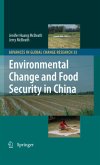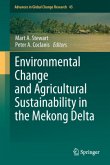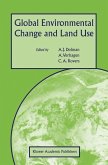With 22 percent of the world's population but only 7 percent of its arable land, China's food situation is a matter of global concern. This volume is the first to introduce comprehensively the threats to China's system of food production, distribution, and consumption. It analyzes broad challenges of population growth, urbanization, and extraordinarily rapid economic development. Then it focuses on degradation of China's land, water and air, water sufficiency, and evidence of climate change effects as they adversely affect the food system. The study investigates plant diseases and pests which take a large toll on agricultural production and also considers alien invasive species.
Normal bureaucratic routines of agricultural, land, water, climatological, and environmental agencies are inadequate to counter these challenges, and the regime has launched large projects (e.g., the South-North Water Diversion Project) and conducted national campaigns (e.g., re- and afforestation programs) which are unprecedented in their scope. Also, China has invested more heavily in agricultural biotechnology research than any other developing country. These responses have insured self-sufficiency in food staples to the present.
The volume evaluates several future problems and issues in China's approach to food security. Despite attempts to tighten coordination of policy and improve enforcement, as seen in efforts to resolve the tainted products crisis of 2007, the increased autonomy of local governments often frustrates green and clean ambitions of the state. Although the regime has tolerated environmental and other NGOs, allowed the media greater latitude to report bad news, and permitted protests that do not challenge the communist party's authority, still civil society is weak. While economic development has lifted more than 200 million from poverty, rural/urban inequality increases, pushing the poor into China's cities, and access to food remains a problem for many.
Abstract This chapter defines food security as the condition reached when a nation's population has access to sufficient, safe, and nutritious food to meet its dietary needs and food preferences. It stresses China's importance to global food security because of its population size. The chapter introduces the contents of the volume and then treats briefly food security in ancient and dynastic (211 bc-1912) China. It examines environmental stressors, such as population growth, natural disasters, and insect pests as well as imperial responses (for example, irrigation, flood control, storage and transportation systems). The chapter also briefly int- duces the Republican era (1912-1949) and compares environmental stressors and government responses then to those of the imperial period. Keywords Food system - Food security - Food production regions - Environmental stressors (Population growth - Natural disasters - Insect pests and Plant diseases - Deforestation - Climate change) - Irrigation systems - Flood control - Grand Canal 1. 1 The Problem of Food Security and Environmental Change Food is the material basis to human survival, and in each nation-state, providing a system for the development, production, and distribution of food and its security is a primary national objective. Many forces have influenced the food security of peoples since ancient times, with particular challenges from natural disasters (floods, famines, drought, and pestilence) and growing populations globally.
Normal bureaucratic routines of agricultural, land, water, climatological, and environmental agencies are inadequate to counter these challenges, and the regime has launched large projects (e.g., the South-North Water Diversion Project) and conducted national campaigns (e.g., re- and afforestation programs) which are unprecedented in their scope. Also, China has invested more heavily in agricultural biotechnology research than any other developing country. These responses have insured self-sufficiency in food staples to the present.
The volume evaluates several future problems and issues in China's approach to food security. Despite attempts to tighten coordination of policy and improve enforcement, as seen in efforts to resolve the tainted products crisis of 2007, the increased autonomy of local governments often frustrates green and clean ambitions of the state. Although the regime has tolerated environmental and other NGOs, allowed the media greater latitude to report bad news, and permitted protests that do not challenge the communist party's authority, still civil society is weak. While economic development has lifted more than 200 million from poverty, rural/urban inequality increases, pushing the poor into China's cities, and access to food remains a problem for many.
Abstract This chapter defines food security as the condition reached when a nation's population has access to sufficient, safe, and nutritious food to meet its dietary needs and food preferences. It stresses China's importance to global food security because of its population size. The chapter introduces the contents of the volume and then treats briefly food security in ancient and dynastic (211 bc-1912) China. It examines environmental stressors, such as population growth, natural disasters, and insect pests as well as imperial responses (for example, irrigation, flood control, storage and transportation systems). The chapter also briefly int- duces the Republican era (1912-1949) and compares environmental stressors and government responses then to those of the imperial period. Keywords Food system - Food security - Food production regions - Environmental stressors (Population growth - Natural disasters - Insect pests and Plant diseases - Deforestation - Climate change) - Irrigation systems - Flood control - Grand Canal 1. 1 The Problem of Food Security and Environmental Change Food is the material basis to human survival, and in each nation-state, providing a system for the development, production, and distribution of food and its security is a primary national objective. Many forces have influenced the food security of peoples since ancient times, with particular challenges from natural disasters (floods, famines, drought, and pestilence) and growing populations globally.








